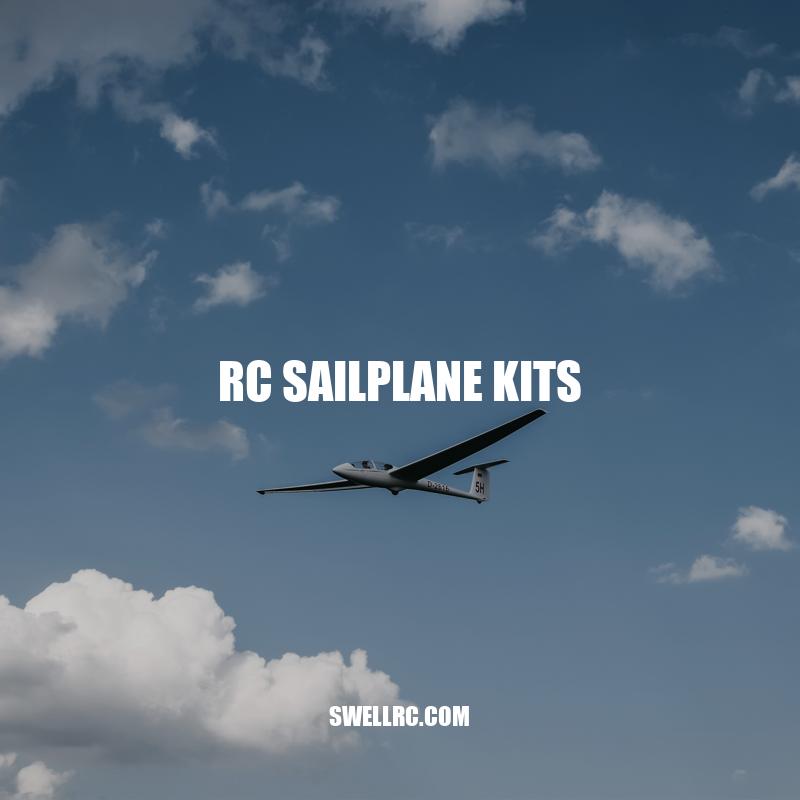Beginner’s Guide to RC Sailplane Kits: Features, Benefits, and Tips
RC sailplane kits are an excellent way to experience the joy of flying model aircraft. The kits come with all the necessary parts required to build a sailplane, and they are available for both beginners and advanced aircraft enthusiasts. The sailplanes come in various shapes, sizes, and designs, and they are made of lightweight materials like balsa wood and carbon fiber. They are a perfect choice for those who are looking for a relaxing and exciting hobby or have a passion for flying aircraft.
One of the benefits of an RC sailplane kit is that it is easy to assemble, even for those who are new to the hobby. The kits come with detailed instructions for how to build the sailplane, and the manufacturers ensure that all the necessary parts are included. With some basic tools like a hobby knife, sandpaper, and glue, it usually takes between 20 and 30 hours to complete a simple sailplane kit. More advanced kits can take longer but can provide a greater challenge and result in a more detailed and intricate sailplane.
Another great benefit of RC sailplane kits is that they are perfect for flying in areas with limited space. Unlike regular model airplanes, sailplanes can be flown in smaller areas, making them perfect for parks, open fields, or even backyards. Additionally, these planes are designed to soar and stay up in the air for a long time, allowing for extended and enjoyable flights.
Overall, RC sailplane kits are an excellent way to experience the thrill of flying without having to invest in expensive and challenging-to-master aircraft. They come with all the necessary parts, are easy to assemble, and can be flown in small and limited areas. With these benefits, it’s no wonder that RC sailplane kits are becoming more and more popular among hobbyists and enthusiasts alike.
Features of RC Sailplanes
The best RC sailplane kits come with several features that make them popular among beginners and experienced flyers alike. Here are some of the key features to look for when shopping for an RC sailplane kit:
- Durable construction materials like carbon fiber, balsa wood, and foam ensure that the sailplane can withstand crashes and collisions.
- Easy-to-use controls like ailerons and elevator allow for straightforward maneuverability and can be controlled with a small handheld remote or transmitter.
- Variable airfoil shapes that can be adjusted to fit particular weather patterns give sailplanes the ability to function efficiently.
- Some sailplanes come with built-in flaps which can help control the glide and enhance the climb that the sailplane is capable of.
- The length of a sailplane can vary depending on intended use or skill level of flyers.
- Some models feature innovative designs and unique shapes that can help soaring in windy areas.
It is worth noting that various websites like Horizon Hobby, Stevens AeroModel, and Tower Hobbies offer a wide range of RC sailplane kits that come with different features and designs. These companies also offer tailor-made flying and maintenance accessories, helping to ensure flyers can continue to enjoy their sailplane for years to come.
What is unique about sailplanes?
Sailplanes are unique in their dynamic sophistication and high aspect ratio wings. Unlike other aircraft types, sailplanes lack powered engines and rely on being towed to launch altitude or using small auxiliary engines. For those interested in learning more about sailplanes, there are many websites and products available that offer information and resources to enthusiasts.
Choosing the right RC sailplane kit can be a challenging task, but with a little research, you can find the kit that meets your needs. Here are some factors to consider when selecting an RC sailplane kit:
- Level of Experience: If you are a beginner, it is recommended to start with a simpler model kit. More complex RC sailplane kits require more advanced flying skills.
- Budget: RC sailplane kits come in a wide range of prices, depending on the features they offer. Consider how much you are willing to spend before selecting a kit.
- Type of Flying: Different sailplane kits offer various features to cater for different types of flying, including thermal soaring, slope soaring and aerobatics.
- Kit Size: The size of your sailplane kit depends mainly on your intended use and preference. Ensure you have ample space for the kit before making a purchase.
- Materials: Consider the quality and durability of materials used in constructing the sailplane kit. Some kits may use cheaper and less durable materials leading to inferior flight and decrease the lifespan of the sailplane kit.
It is interesting to note that RC sailplane kits can be customized to meet specific needs and preferences. By utilizing online resources like RC Groups, users can find useful tips on how to modify and enhance their sailplane kit. Also, some websites like Amazon, eBay, and Alibaba offer a vast range of affordable and quality RC sailplane kits alongside other flying accessories.
How do I choose the right motor for my RC plane?
When selecting a motor for your RC plane, consider the kv rating and size of the motor. A higher kv and smaller propeller will produce more speed, so for a beginner’s plane, choose a motor with a kv rating between 850 and 1500. As for size, choose a motor that will fit comfortably in the plane without weighing it down. Several websites offer motors that meet these criteria, such as HobbyKing and Motion RC.
Assemble the perfect RC Sailplane Kit with these helpful tips:
Before starting, be sure to read through all the instructions and study any diagrams provided. Work on a clean and organized workspace to reduce the risk of losing or damaging any parts. Building an RC sailplane takes time and patience, so be sure to take breaks when necessary and don’t rush.
Breaking the construction process into stages will help you progress smoothly. Start by building and testing the control surfaces, and then move on to the wings before progressing to the fuselage and tail.
Don’t be afraid to ask for help. If you’re struggling with a particular step, search for online resources such as instructional videos, or ask an experienced model airplane enthusiast for help.
To construct your sailplane kit, make sure to test the controls, ensure that all parts are aligned and fitted correctly, and make necessary adjustments before finalizing your sailplane. Amazon and Tower Hobbies offer a vast range of tools and accessories required when building an RC sailplane such as, carbon fiber tubes, balsa wood, various glues, and brushless motors.
These tips will help you build your RC Sailplane with ease. If you have any questions or need additional resources, feel free to check out our website for more information and products related to RC Sailplane Kits.
How to build a RC glider plane?
To build a RC glider plane, you will need to first gather all the necessary materials and tools such as balsa wood, foam, glue and RC components. Next, design the plane using a computer-aided design software or utilize pre-designed plans from websites such as Flite Test or RCGroups. Then, start building the glider by cutting and assembling the different parts of the plane. After the assembly is complete, install the RC components such as the motor, receiver and servos. Finally, test fly your glider in a safe and open area. It’s important to remember to follow all safety precautions and guidelines. There are also several instructional videos and tutorials available on YouTube and various RC hobby websites to assist you in building your own glider plane.
RC Sailplane kits are a great way to get into the world of model airplanes. With a little patience and skill, you can build a model airplane that will soar through the air with the grace of a real bird.
When it comes to RC sailplane kits, there are many options on the market. Some popular brands include Horizon Hobby’s sailplanes, Tower Hobbies’ sailplanes, and RC sailplane kits on Amazon.
To get started with an RC sailplane kit, you’ll need some tools, including a building board, razor blades, sandpaper, and glue. It’s also important to follow the instructions carefully to ensure that your sailplane is built safely and correctly.
One great thing about RC sailplane kits is that they allow you to customize your model airplane to your liking. You can choose the color scheme, add decals, and even choose your own radio control system.
When it comes to flying your RC sailplane, there are a few things to keep in mind. Start with short flights to get used to the controls and the sailplane’s behavior. Practice gliding and try to find a thermal to keep the sailplane airborne. Experiment with different types of soaring, such as slope soaring by flying your sailplane near hillsides or mountainsides.
If you’re looking to get more involved with the RC sailplane community, consider joining a club or a group of model airplane enthusiasts. Websites like Horizon Hobby offer a wide range of sailplane accessories, such as spare batteries, chargeable controllers, backup servos, and parts to repair broken sailplanes.
Overall, RC sailplane kits offer a rewarding and entertaining hobby that allows you to learn and apply technical knowledge while building and testing a remote-controlled sailplane that can often stay airborne without the use of fuel.
How do you learn to fly a model plane?
Learning to fly a model plane requires practice, patience, and the right resources. One way to learn is by watching tutorial videos such as the one available on YouTube (https://www.youtube.com/watch?v=3sdJCQ3Ic8I). Additionally, joining model plane clubs or finding a mentor can also be helpful. It’s important to start small and gradually work your way up to larger and more complex models. Proper maintenance and safety precautions are also crucial when operating model planes.
Popular RC Sailplane Kits
There are several popular RC sailplane kits on the market that are designed for both beginners and experienced users. Here are some of the most highly-rated models:
- Sig Riser: A classic model that is popular among beginners. It’s easy to construct, and the kits come with all the necessary materials.
- Graupner Mini Discus: An ideal model sailplane for beginners. It features a wingspan of 36 inches and weighs less than a pound which makes it easy to handle.
- Phoenix Model ASK 21: This model is great for intermediate and advanced users. It is made of balsa wood and comes with carbon fiber reinforcements which give it the ability to glide and catch thermals with ease.
- Blaster 2: It is ideal for advanced users who want speed and performance. It has a wingspan of 60 inches and weighs less than 18 ounces.
While there are numerous options available, it’s important to choose an RC sailplane kit that matches your skill level. Websites like “Tower Hobbies” and “Value Hobby” offer a wide range of sailplane kits and accessories for the best flying experience. Customers can surf through product descriptions, ratings and also compare models to make an informed choice.
Additionally, websites like “RC Groups” and “Sailplanes and Electric Gliders” are excellent communities for remote control plane enthusiasts to chat, exchange DIY project ideas and insights.
It’s important to research and select the sailplane kit that meets your budget and expectations to have an enjoyable and safe flying experience.
What are the most popular glider planes?
According to Burt, the ASK 21 is probably the most popular glider plane in the world. It is a two-seat fiberglass glider built in Germany designed for primary instruction, but can also be used for aerobatic instruction or cross-country flying. Source: Wikipedia’s Schleicher ASK 21 page.
Conclusion
In conclusion, RC sailplane kits offer a fun and exciting way to enjoy the outdoors while pursuing a creative hobby. From beginners to advanced model airplane enthusiasts, there is a kit that caters to all levels of skill and flying experience. It’s essential to choose a sailplane kit that suits your requirements and budget, take time to construct it properly, and practice flying to develop your skills.
RC sailplanes provide an opportunity for users to enjoy a variety of techniques such as thermal soaring, slope soaring, and aerobatics. Purchasing a kit from reputable websites, attending local flying clubs and being part of a community of enthusiasts are excellent resources to hone your skills, troubleshoot challenges and learn about newly developed models.
The use of carbon fiber, balsa wood, and foam materials along with integrated technology has allowed sailplane design to evolve dramatically over the years. If you’re looking for a relaxed and enjoyable flying experience, or an exhilarating high-performance thrill, there is an RC sailplane kit on the market for everyone.
Overall, the world of RC sailplane kits provides endless opportunities for users to tailor their flying experience, showcase their creativity, and engage with a passionate community of enthusiasts.



